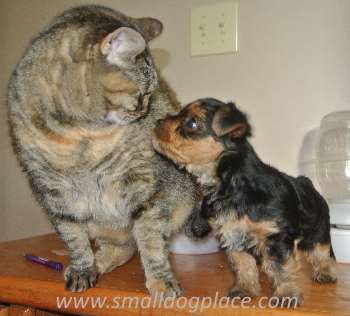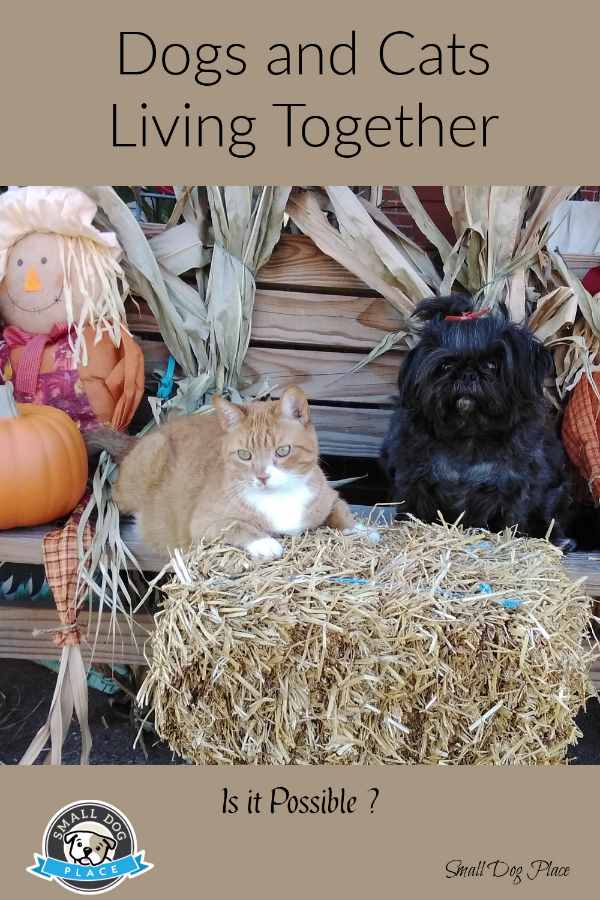Are your dogs and cats living together under the same roof, soul mates, best friends, or mortal enemies?
By Janice Jones M.A. |Last Updated 10-23-2021
Modern dogs and cats have lived side by side for many
generations, some forming strong bonds that transcend the obvious
species
difference.
Others live in the same household, cognizant of each others presence but otherwise prefer to lead distinct lifestyles where
there is seemingly an unspoken rule:
No cats allowed in the dog
quarters, and
No dogs allowed where the cats reside.
Popular culture would have us believing in this great schism, but does
this divide really exist in
actual households?

Everyone who has ever lived with both cats and dogs will
have a tale to tell about the incredible
bonds between their cat and dog.
They
not only tolerate each other, but they also
thrive in each others company,
follow each other around, sleep in each others beds, play together, even eat each
others’ food.
Others will reveal
that their cat and dog will have nothing to do with each other. One occupies the space in the kitchen and the
other dominates in the bedroom; neither will venture across the invisible
boundaries that separate their worlds.
 Abby and Sam are settling in for a nap together–A Great Example of Dogs and Cats Living Together, Happily
Abby and Sam are settling in for a nap together–A Great Example of Dogs and Cats Living Together, HappilySo, what really does go on in
households where there are both dogs and cats living together?
It is true that many people have a preference for one type of pet over
the other. You know the routine:
I’m a cat person, I’ll never have a dog.
I’m a dog person, and am not fond of your feline friend.
What happens
when a cat person meets a dog person?
Are they doomed to incompatibility?
Maybe not.
Dogs and cats can live harmoniously with each other, but it
does take some foresight and planning, especially if you want your cat to love
your dog and not just agree to co-exist.
A lot depends on the type of
dog breed you choose and whether you will be introducing a young puppy
to a mature cat or a kitten to an older dog.
Best case scenario would be to add
cats and dogs together at a very young
age.
Some breeds of dogs are just more tolerant of cats. There is also a major debate as to whether a
kitten would be best introduced to a mature dog or a puppy brought into the
household with an adult cat.
 Isis and Tucker are Checking Each Other Out
Isis and Tucker are Checking Each Other OutSome breeds, such as the greyhound has a strong chase
instinct and don’t do well with cats.
Other breeds have strong prey instincts and will chase them, nip at them
and otherwise harass them. Many of the
terrier breeds are like this. Then, there are some breeds that hate cats (and
other small pets)
Dog Breeds that Hate Cats
Many cat experts will
tell you that an adult cat who has never had any experience living with or near
dogs will have a harder time making the transition to a lifestyle with a busy, rambunctious
puppy.
If, however, the adult cat has
been exposed to dogs, there is a reason to
suspect that the pair will tolerate each other
if not become friends. Smaller, calmer dogs seem to do best with their cat
co-inhabitants.
Dogs and Cats Living Together: Does Size Matter?
Large breed puppies with very high energy levels may just overpower
a cat.
There are, however, many success
stories of families with a larger or giant breed dog loving and protecting the
family’s cat. In these situations, the
dog was the first family member followed by an adult cat or kitten
If you have your heart set on
a family with one dog and one cat, consider adopting them when they are
young say under one-year-old.
Even though it might seem like a lot of
work, experts and pet owners agree that taking
in both a cat and a dog within a short time of each other produces the best
chance for successful bonding between the species.
Dog Breeds Developed to Be Companions
Each dog breed history normally starts out with something such as this: This breed was developed to hunt fox, guard flocks of sheep or trained as a war dog. There is absolutely nothing wrong with any of these noble jobs, but some breeds were bred solely to be companions to their humans.
These companion breeds keep nobility company, warmed the laps of queens living in drafty castles or helped turn prayer wheels in ancient monasteries.
A breed that has always been considered a companion may make the best choice if you are considering adding a dog to your cat household.
Consider:
Maltese, Shih Tzu, Cavalier King Charles Spaniel, Pug, Lhasa Apso, or Tibetan Spaniel.
 Dogs and Cats Living Together? It Does Happen!
Dogs and Cats Living Together? It Does Happen!The next option would be to get two pets, a cat, and a dog, who have had a history of being
around other pets. Here, you would not
need to get a puppy and a kitten.
This brings a sigh of relief to many who find
the prospects of training both a kitten and a puppy at the same time to be
daunting experience—one which the normally sane individual would prefer to shy
away from.
Many people are likely to adopt a kitten or young cat from a
rescue or shelter. The benefits of this situation are great.
You not only save a life, but you might also
gain some information about the former life of the kitten or cat you are planning
to adopt. Find a cat that has already
been exposed to living with a dog.
The same holds for selecting
a puppy or dog. If you can find a rescue who can get you a dog that has already been
introduced to cats, you will be well ahead of the game.
A dog breeder may also be able to introduce
your new puppy to her cats, giving you a head start on the bonding process.
All of this is discussion is
assuming that you plan to acquire a dog and a cat at about the same time. This could be an ideal situation, but for the
majority of people, this best case scenario may not be what happens in
reality.
When Dog Meets Cat: Successful Introductions
Never assume that the cat of your dreams will automatically
love the dog in your life. If Cats already rule your household, don’t expect
them to roll out the welcome mat to a new canine addition whether it is a young
puppy, adolescent or adult dog.
Short and sweet introductions are usually the best and the ones that are entirely supervised will lead to
the best outcomes. Never leave a puppy and cat alone together or kitten and an older
dog and hope for the best.
New additions
to the family must be introduced slowly and cautiously with ever present human
supervision close at hand. What exactly
does it mean to supervise?
Dogs and Cats Living Together: Human Intervention Required!
Humans have an advantage over
pets. We are usually the parent, the
alpha male or female, or the leader of the pack.
Animals have an instinctive understanding
that they may not be entirely in charge if a human is present. If they don’t, it is our responsibility to
let them know who the parent is in the relationship.
The person who supervises the
first few encounters with dogs and cats/puppies and kittens or any other
combination should understand that they must intervene if a fight breaks out or
if one of the pair feels threatened in any way.
Quick reflexes might be needed to protect a puppy or kitten from the
jaws of the other if it looks like both are not going to get along, or
bond.
The last thing you want is for a
puppy to be clawed or a kitten to be injured to the point where veterinary
surgery might be necessary.
Quick Tricks for Dogs and Cats Living Together
- Introduce the pair after they’ve
eaten and are both relaxed - Keep the dog on a leash and
the cat on the other side of the room - Allow them to smell each
other first. Scent is important to both
dogs and cats - Provide treats for both – You
want them to associate treats with being with each other - Watch both animals for warning
signs that something is not right. This
means watching their body language. - Leave them in a small room but
stay near enough to intervene if necessary - Don’t allow the cat to run
away—the dog will immediately look at this as a game of chase. - Don’t punish either animal
for aggression. You don’t want your dog
thinking he will get into trouble if the cat is around. He might decide that
his job is to fend off the cat at all costs. - Provide a tall scratching
post/tower with multiple landings for the cat to rest and observe the dog from
a high perch.
If the first meeting doesn’t
go well, don’t give up. Stock up on more
treats and try again tomorrow. It make
take many short meetings until the two are comfortably together in each others
presence.
How will I keep them apart
when I’m away from home?
Dogs are much easier to
confine than cats. Crating the dog may
be the solution if someone will be available to let him out at noontime for a
walk.
If crating is not an option, you
may need to separate them in different rooms separated by a door. Infant gates work great for keeping a puppy
confined, but cats will view a gate as a minor inconvenience if she wants to
get to the puppy.
Once you feel comfortable
that they will get along, these extra precautions may not be necessary.
Last Words about Dogs and Cats Living Together
To conclude, if you want to
share your home with a dog and cat, relax it can be done. Will they become soul mates to each
other? No guarantees there, but cats and
dogs can be taught to form bonds and become friends.
It takes a little patience and time on your
part and enough knowledge of dog breeds to chose a dog that naturally will get
along with a cat.
Many households have dogs and cats living together, peacefully and happily. Will your home be one of them?
Adoption Resources
Your local animal shelter, humane society or rescue organizations are always an idea place to look adoptable pets. If you’d like to do a search online, may we suggest:
Petfinder.com
Pin for Future Reference
 Dogs and Cats living together pin image
Dogs and Cats living together pin imageDoes This Article Deserve Your Thumbs Up?
We always appreciate your support and encouragement. Your thumbs up means so much to us. Please like this article.
If you find this page or any page on Small Dog Place Helpful, or Useful in anyway, I’d love it if you would click the small heart found on the bottom right of each page.
You can also share or bookmark this page — just click on the:

Free Monthly Newsletter
Sign Up for Our Free Newsletter and get our Free Gift to You.
my E-book, The Top 10 Mistakes People Make When Choosing a Dog (and how to avoid them)


